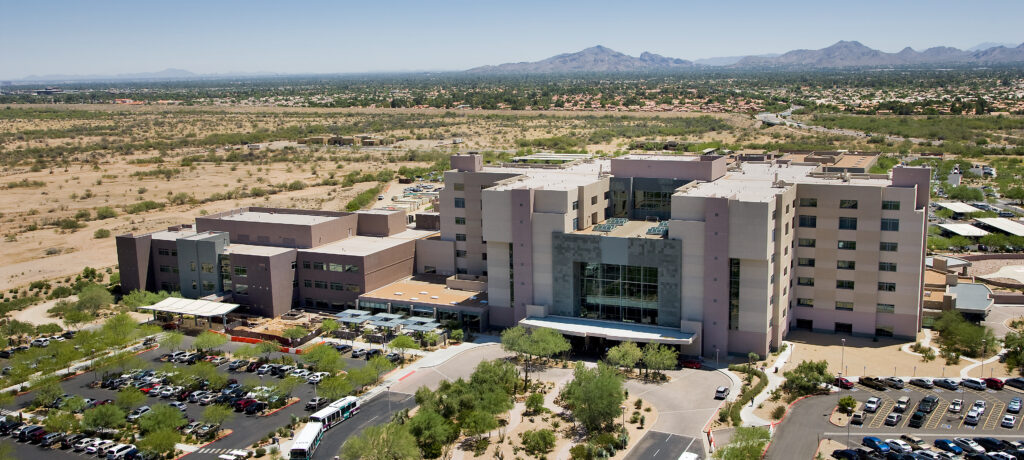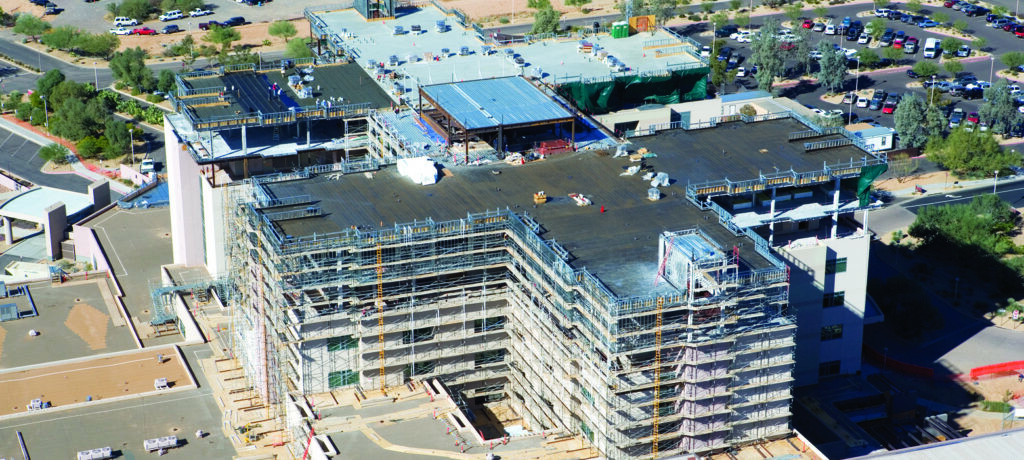Kitchell’s legacy with Mayo Clinic helped shape the foundation of world-class healthcare in Arizona. The partnership began in 1987 with the construction of Mayo’s first facility in the state—an outpatient clinic in Scottsdale—and evolved over nearly four decades into a series of technically demanding projects that expanded Mayo’s footprint across the Southwest. Among them: Arizona’s first Mayo Clinic hospital, completed in 1998, which was also the first in the nation designed entirely by Mayo physicians and staff. From complex infrastructure to vertical expansions, Kitchell’s work has left a lasting mark on the built environment supporting one of the nation’s most respected medical institutions.
Breaking New Ground in Desert Healthcare
The relationship began with a milestone moment. In 1987, Kitchell constructed Mayo Clinic’s first-ever facility in Arizona—an achievement that established Mayo’s presence in the Southwest. When the Scottsdale clinic opened its doors on June 29, it launched with 47 physicians and 225 allied health staff, and had already booked 1,800 patient appointments before the clinic’s opening day (Mayo Clinic, 2012). More than a single project, the project marked the beginning of a collaboration that would evolve alongside Mayo’s regional growth.
By 1995, that foundation led to one of Mayo Clinic’s most ambitious undertakings: its first hospital in the nation designed entirely by its own physicians and staff. Kitchell was selected by the Board of Trustees to bring that vision to life, delivering a 440,000-square-foot hospital and central plant on a 200-acre desert site in Phoenix, Arizona. Completed on time and within budget, the facility reflected Mayo’s uncompromising standards for quality, functionality, and care.
Meanwhile, progress also continued back at the original Scottsdale clinic, with the design-build delivery of the first additional concourse and underground parking structure. The 244,000-square-foot addition featured angled parking, wide drive aisles, superior lighting, and four times the shell space offered by competing proposals—raising the bar for healthcare campus design.
That ingenuity extended to construction methods as well. When faced with the challenge of cutting through 29 feet of vertical wall, Kitchell deployed a modified pipeline trencher to complete perimeter wall construction and shoring in a single operation. The result: five weeks saved and zero disruption to hospital operations—a project highlight that reinforced Kitchell’s reputation for creative problem-solving and seamless execution in highly-sensitive environments.
Vertical Expansion in a Live Environment
In the following decade, the Phoenix hospital campus underwent a vertical expansion that added more than 104,000 square-feet across two new floors built directly above the active hospital. The program included six new operating rooms, 36 inpatient beds, expanded emergency and dining areas, and five new elevators extending the existing core.
Executing this scope in a fully operational medical environment required extraordinary precision. Construction start times were shifted to reduce disruption, major structural work was timed for periods of lower patient volume, and close coordination ensured uninterrupted access to clinical services throughout the build.
What emerged wasn’t just a vertical expansion—it was a disciplined feat of engineering, executed within an active hospital with the focus and precision of an operating room.
A Track Record of Technical Delivery
Since the original clinic, Kitchell has completed more than 80 projects across Mayo Clinic’s Arizona campuses—from radiology and lab upgrades to nuclear medicine suites, shielded imaging rooms, and critical infrastructure improvements. Across each, the goal remains the same: create environments that support advanced care while preserving operational continuity.
This work has included over 400 miles of structured cabling, complex HVAC and MEP systems, and the expansion of highly specialized diagnostic spaces. With experience in both general contracting and design-build delivery, Kitchell has long been trusted to execute some of Mayo Clinic’s most technically demanding healthcare projects—requiring deep expertise, clinical foresight, seamless coordination, and the flexibility to build without disrupting patient care.
Kitchell’s expertise extended into academic medicine with the 2017 construction of the Mayo Clinic Alix School of Medicine in Scottsdale—the first medical school in Arizona. The 18,000-square-foot facility was designed to foster innovation and hands-on learning, featuring advanced simulation labs and collaborative spaces with panoramic views of the McDowell Mountains. Purpose-built to support Mayo’s forward-thinking curriculum in healthcare delivery and biomedical informatics, it remains one of only five medical schools in the state, underscoring Kitchell’s role in shaping the future of healthcare and medical education.
A Shared Vision for Healing Spaces
What began with Kitchell building Mayo Clinic’s first Scottsdale facility in 1987—a pioneering clinic in the desert—has become a defining chapter in our 75-year history. Built on shared values, mutual trust, and a commitment to excellence, the relationship between Mayo Clinic and Kitchell continues to elevate healthcare infrastructure across the region.
As medicine advances, so has Kitchell’s role in shaping it—each project building on the last, each solution reinforcing a vision for what healthcare environments can and should be. These efforts have delivered more than cutting-edge facilities. They’ve created spaces that heal, educate, and drive innovation for generations to come.

